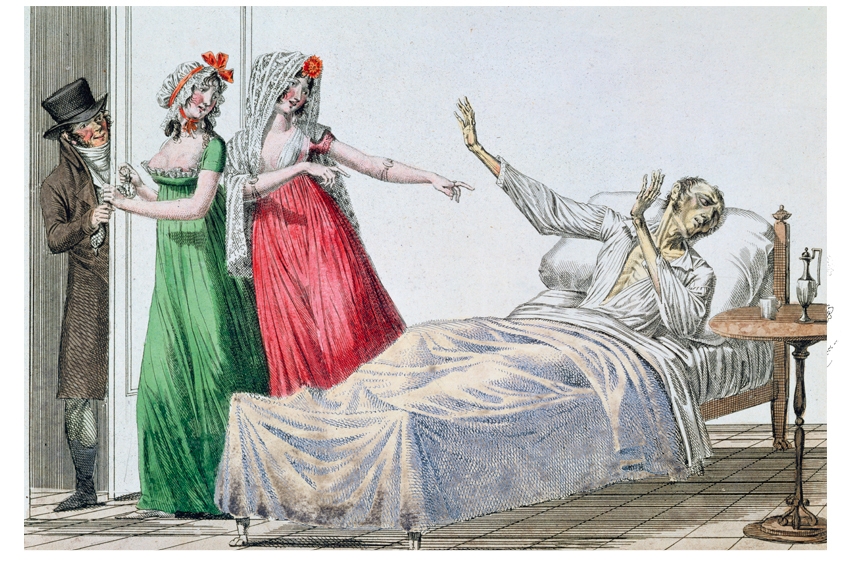When I saw the title of this book, then read that it only covered the period 1600-1800 I hoped this would be a riot of comedy, something along the lines of the most wonderful sentence in the English language. This is in Havelock Ellis’s Psychology of Sex and concerns a discovery made by the doctor Realdus Columbus: in 1593, a century after his namesake discovered the New World, this great man claimed to have discovered the clitoris.
But no, there is no comedy, apart from the doings of one Frances, Lady Purbeck, who in 1635, with the son of the Earl of Suffolk, lived happily and ‘adulterously’ in what the author calls ‘the depths of Shropshire’. Unfortunately the couple for some reason decided to visit London, where the prim little meddler Charles I, alerting the Archbishop of Canterbury, got them slapped in gaol. But Frances, disguised as a man, escaped to Paris, where, with the Archbishop’s posse still on her trail, she converted to Catholicism and entered a convent. Here, naturally, she fell out with the nuns and did another runner, disappearing this time not just from the convent but from history. She must have been a real goer, this Frances, for she provides the one moment of daylight in this book.
The Origins of Sex is about the legal and religious attempts to regulate sex outside marriage. It is thus social history, only, as you might expect, it becomes a social history of cruelty and lunacy. In 1650, under the Saints, Parliament passed an act which made adultery a capital offence, and Cromwell’s own brother-in-law supervised the hanging of an adulteress in Taunton, women being then regarded as the more culpable agents, leading men by the nose, or whatever, into sin.
Only then there was the problem of rape. Our ancestors got over this by the belief, persisting well into Pepys’s time, that for a woman to become pregnant she had first to have had an orgasm. Thus in 1632 a young woman in Waltham Holy Cross was actually made to do penance, even though before the rape she had been dragged across the fields and beaten up by the man who then fathered a child on her. They were horrible, horrible people, our ancestors, so, if it does nothing else, this book does make you start to believe in some human progress.
Religion was the real complicating factor. In 1644 a New World settler got this very badly and made a public confession of sins that included his failed attempt to have sex with a young woman. The authorities managed to trace her and hanged the two of them, she on the scaffold confessing her terrible crime against God and society. She was 18 years old. Our ancestors were not just horrible, they were barking, and Trevelyan will never be the same after such histories.
Then there was a sudden change. In the 18th century, women began to be seen, not as the aggressors in sex, but as the victims: men, usually rich, became stock characters as agents of seduction in novels. And not just in novels. The infamous rapist, and very rich money-lender, Colonel Charteris married his daughter into the family of the Earl of March, whose family promptly and gratefully changed their name to Charteris, which it remains to this day. The rich always did hear a different drummer, though local people were a nuisance, given their habit of digging up Charteris’s grave to see if he was still in it.
But the fear of sex persisted. The 18th- century judge Lord Monboddo wrote that it was so enjoyable it derailed the life of the mind. Still there were those who tried to get it into some kind of human perspective. A remarkable young woman of 27, the Hon. Jean Kames, her adultery discovered, said airily that she was just gratifying ‘those passions which [God] had implanted in her nature’. John Wilkes in his poem ‘Essay on Women’ wrote, ‘Life can little more supply/ Than just a few good fucks, and then we die.’
Then there were the real head-bangers. The Beggars’ Benison was a sort of 18th-Scottish Rotary Club, except the ceremonial rites of these Rotarians included masturbating communally into a pewter platter, now one of the treasures of Prince William’s alma mater, St Andrews University, which keeps it under lock and key. And then there was polygamy, about which Boswell, who wanted a harem of 30, could only fantasise to Rousseau (who demurred). This became a reality with the 19th-century Oneida Community in New England, which held everything in common, including women, until it broke up; at which point, I read somewhere, it proved impossible to borrow a hammer.
Some odd facts. Jeremy Bentham, now stuffed, wrote in defence of homosexuality, then a capital offence (between 1810 and 1831 46 men were hanged for buggery), and said that Christ had enjoyed such a relationship with St John. It remained a criminal offence in living memory — my living memory — but, curiously, while it constituted five per cent of all crimes against the person at the time of Wilde’s prosecution, half a century later, in the 1950s, this had become 20 per cent, involving thousands of prosecutions a year.
Even more curiously, while the European Court of Human Rights has ruled that sado-masochistic homosexual acts are against the law, it is perfectly legal to brand your wife on her buttocks with a hot iron.
This is a very bleak book in which you meet humanity at its silliest and most cruel.






Comments